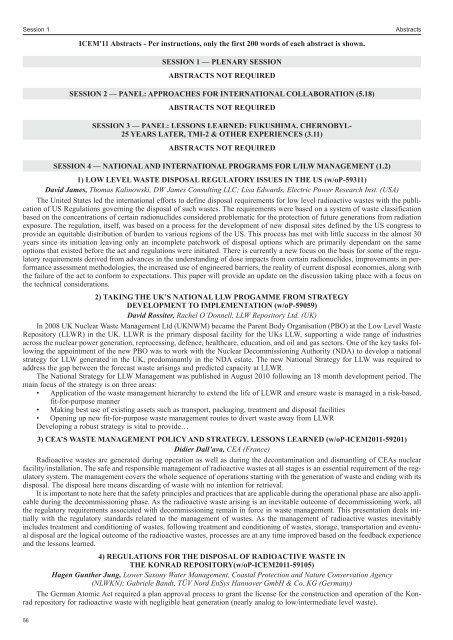ICEM11 Final Program 9.7.11pm_ICEM07 Final Program ... - Events
ICEM11 Final Program 9.7.11pm_ICEM07 Final Program ... - Events
ICEM11 Final Program 9.7.11pm_ICEM07 Final Program ... - Events
You also want an ePaper? Increase the reach of your titles
YUMPU automatically turns print PDFs into web optimized ePapers that Google loves.
Session 1 Abstracts<br />
ICEM'11 Abstracts - Per instructions, only the first 200 words of each abstract is shown.<br />
SESSION 1 — PLENARY SESSION<br />
ABSTRACTS NOT REQUIRED<br />
SESSION 2 — PANEL: APPROACHES FOR INTERNATIONAL COLLABORATION (5.18)<br />
ABSTRACTS NOT REQUIRED<br />
SESSION 3 — PANEL: LESSONS LEARNED: FUKUSHIMA, CHERNOBYL-<br />
25 YEARS LATER, TMI-2 & OTHER EXPERIENCES (3.11)<br />
ABSTRACTS NOT REQUIRED<br />
SESSION 4 — NATIONAL AND INTERNATIONAL PROGRAMS FOR L/ILW MANAGEMENT (1.2)<br />
1) LOW LEVEL WASTE DISPOSAL REGULATORY ISSUES IN THE US (w/oP-59311)<br />
David James, Thomas Kalinowski, DW James Consulting LLC; Lisa Edwards, Electric Power Research Inst. (USA)<br />
The United States led the international efforts to define disposal requirements for low level radioactive wastes with the publication<br />
of US Regulations governing the disposal of such wastes. The requirements were based on a system of waste classification<br />
based on the concentrations of certain radionuclides considered problematic for the protection of future generations from radiation<br />
exposure. The regulation, itself, was based on a process for the development of new disposal sites defined by the US congress to<br />
provide an equitable distribution of burden to various regions of the US. This process has met with little success in the almost 30<br />
years since its initiation leaving only an incomplete patchwork of disposal options which are primarily dependant on the same<br />
options that existed before the act and regulations were initiated. There is currently a new focus on the basis for some of the regulatory<br />
requirements derived from advances in the understanding of dose impacts from certain radionuclides, improvements in performance<br />
assessment methodologies, the increased use of engineered barriers, the reality of current disposal economies, along with<br />
the failure of the act to conform to expectations. This paper will provide an update on the discussion taking place with a focus on<br />
the technical considerations.<br />
2) TAKING THE UK’S NATIONAL LLW PROGAMME FROM STRATEGY<br />
DEVELOPMENT TO IMPLEMENTATION (w/oP-59059)<br />
David Rossiter, Rachel O’Donnell, LLW Repository Ltd. (UK)<br />
In 2008 UK Nuclear Waste Management Ltd (UKNWM) became the Parent Body Organisation (PBO) at the Low Level Waste<br />
Repository (LLWR) in the UK. LLWR is the primary disposal facility for the UKs LLW, supporting a wide range of industries<br />
across the nuclear power generation, reprocessing, defence, healthcare, education, and oil and gas sectors. One of the key tasks following<br />
the appointment of the new PBO was to work with the Nuclear Decommissioning Authority (NDA) to develop a national<br />
strategy for LLW generated in the UK, predominantly in the NDA estate. The new National Strategy for LLW was required to<br />
address the gap between the forecast waste arisings and predicted capacity at LLWR.<br />
The National Strategy for LLW Management was published in August 2010 following an 18 month development period. The<br />
main focus of the strategy is on three areas:<br />
• Application of the waste management hierarchy to extend the life of LLWR and ensure waste is managed in a risk-based,<br />
fit-for-purpose manner<br />
• Making best use of existing assets such as transport, packaging, treatment and disposal facilities<br />
• Opening up new fit-for-purpose waste management routes to divert waste away from LLWR<br />
Developing a robust strategy is vital to provide…<br />
3) CEA’S WASTE MANAGEMENT POLICY AND STRATEGY. LESSONS LEARNED (w/oP-ICEM2011-59201)<br />
Didier Dall’ava, CEA (France)<br />
Radioactive wastes are generated during operation as well as during the decontamination and dismantling of CEAs nuclear<br />
facility/installation. The safe and responsible management of radioactive wastes at all stages is an essential requirement of the regulatory<br />
system. The management covers the whole sequence of operations starting with the generation of waste and ending with its<br />
disposal. The disposal here means discarding of waste with no intention for retrieval.<br />
It is important to note here that the safety principles and practices that are applicable during the operational phase are also applicable<br />
during the decommissioning phase. As the radioactive waste arising is an inevitable outcome of decommissioning work, all<br />
the regulatory requirements associated with decommissioning remain in force in waste management. This presentation deals initially<br />
with the regulatory standards related to the management of wastes. As the management of radioactive wastes inevitably<br />
includes treatment and conditioning of wastes, following treatment and conditioning of wastes, storage, transportation and eventual<br />
disposal are the logical outcome of the radioactive wastes, processes are at any time improved based on the feedback experience<br />
and the lessons learned.<br />
4) REGULATIONS FOR THE DISPOSAL OF RADIOACTIVE WASTE IN<br />
THE KONRAD REPOSITORY(w/oP-ICEM2011-59105)<br />
Hagen Gunther Jung, Lower Saxony Water Management, Coastal Protection and Nature Conservation Agency<br />
(NLWKN); Gabriele Bandt, TÜV Nord EnSys Hannover GmbH & Co. KG (Germany)<br />
The German Atomic Act required a plan approval process to grant the license for the construction and operation of the Konrad<br />
repository for radioactive waste with negligible heat generation (nearly analog to low/intermediate level waste).<br />
56
















